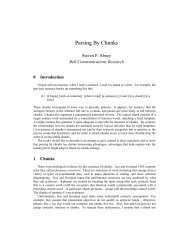The English Noun Phrase in its Sentential Aspect - Vinartus
The English Noun Phrase in its Sentential Aspect - Vinartus
The English Noun Phrase in its Sentential Aspect - Vinartus
You also want an ePaper? Increase the reach of your titles
YUMPU automatically turns print PDFs into web optimized ePapers that Google loves.
1. A PUZZLE AND ITS SOLUTION 21of the noun phrase? and (2) If there is an <strong>in</strong>ectional head of the nounphrase, is the determ<strong>in</strong>er <strong>its</strong> lexical <strong>in</strong>stantiation? In the rst part of thethesis, though I use the symbol \D" to denote the mystery category X, Iam for the most part only concerned with the rst question. In ChapterFour, I turn to the second question: whether <strong>in</strong> fact Determ<strong>in</strong>er = D.1.5 Sentence and <strong>Noun</strong> <strong>Phrase</strong><strong>The</strong> solution I have proposed is, <strong>in</strong> eect, to assign a more sentence-likestructure to the <strong>English</strong> noun phrase than is commonly assumed. This isattractive for conceptual reasons, <strong>in</strong> addition to the empirical advantages itprovides. Verb versus noun is the most fundamental opposition <strong>in</strong> grammar,and it is appeal<strong>in</strong>g to be able to assign the phrases built on them| sentenceand noun phrase, respectively|parallel structure.Similarities between noun phrase and sentence are a recurrent theme <strong>in</strong>grammatical study. Sentence and noun phrase play a dist<strong>in</strong>guished role <strong>in</strong>many aspects of grammar: they were the two cyclic nodes, for <strong>in</strong>stance, <strong>in</strong>earlier versions of transformational grammar they are also the two categorieswhich freelyconta<strong>in</strong> subjects.On the other hand, there are very substantial dierences <strong>in</strong> noun-phraseand sentence structure, which cannot be ignored. A recurr<strong>in</strong>g theme of thethesis is noun-phrase/sentence similarities and dierences. I compare nounphrase/sentencestructure <strong>in</strong> a general way, briey, for completeness' sake.Iamchiey concerned, however, with a s<strong>in</strong>gle sentential aspect of the nounphrase: the existence of an Inectional head of the noun phrase.F<strong>in</strong>ally, while we are on the topic of noun-phrase/sentence parallels, itis perhaps relevant to note that the puzzle of how toputthetwo pieces ofthe Poss-<strong>in</strong>g gerund together is actually the same problem as led to the IPanalysis of the sentence. In earlier generative grammar, the node S stoodout as an exception to a restrictive version of X-bar theory that requiresall phrases to be headed. <strong>The</strong> solution proposed for tt<strong>in</strong>g the pieces ofthe sentence together was to raise the status of a m<strong>in</strong>or category, modal, tohead of the sentence, and to postulate an entirely abstract head <strong>in</strong> sentenceswhich lacked modals. I have simply imported this solution <strong>in</strong>to the nounphrase, to solve the puzzle of the gerund.



